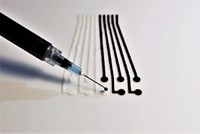Advertisement
Grab your lab coat. Let's get started
Welcome!
Welcome!
Create an account below to get 6 C&EN articles per month, receive newsletters and more - all free.
It seems this is your first time logging in online. Please enter the following information to continue.
As an ACS member you automatically get access to this site. All we need is few more details to create your reading experience.
Not you? Sign in with a different account.
Not you? Sign in with a different account.
ERROR 1
ERROR 1
ERROR 2
ERROR 2
ERROR 2
ERROR 2
ERROR 2
Password and Confirm password must match.
If you have an ACS member number, please enter it here so we can link this account to your membership. (optional)
ERROR 2
ACS values your privacy. By submitting your information, you are gaining access to C&EN and subscribing to our weekly newsletter. We use the information you provide to make your reading experience better, and we will never sell your data to third party members.
Analytical Chemistry
Bubble Wrap As Labware
Pocketed polyethylene sheets can serve as sample storage containers, assay plates in resource-limited settings
by Lauren K. Wolf
July 28, 2014
| A version of this story appeared in
Volume 92, Issue 30
When George M. Whitesides and his research team at Harvard University look at Bubble Wrap, they don’t see packing material or even a sheet of stress relief waiting to be popped. Rather, the researchers see scads of sample containers for the lab. Whitesides’s group has long been adapting everyday items such as eggbeaters and camera phones as low-cost lab equipment and disease diagnostics for the developing world. “Looking at Bubble Wrap, we noticed that the bubbles are in some sense like the ‘wells’ of a well-plate,” the team says. So the scientists tested whether various brands of the polyethylene-based packaging could replace expensive sample well-plates in resource-limited settings (Anal. Chem. 2014, DOI: 10.1021/ac501206m). They injected individual bubbles with aqueous solutions, sealed the punctures with fingernail hardener, and demonstrated that the fluids were stable and didn’t leak for weeks. Then they showed that the bubbles—sterile inside and permeable to gases such as oxygen—can be used to culture microorganisms. And the team proved that the sheets could be preloaded with assay reagents, injected with blood samples, and loaded into a plate reader to determine the samples’ hemoglobin content, an indicator of anemia.




Join the conversation
Contact the reporter
Submit a Letter to the Editor for publication
Engage with us on Twitter